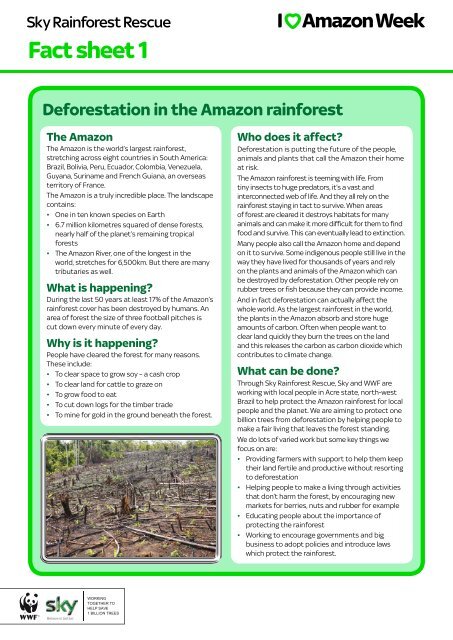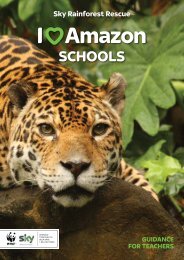Fact sheet 1
Fact sheet 1 - Sky Rainforest Rescue
Fact sheet 1 - Sky Rainforest Rescue
Create successful ePaper yourself
Turn your PDF publications into a flip-book with our unique Google optimized e-Paper software.
<strong>Fact</strong> <strong>sheet</strong> 1<br />
Deforestation in the Amazon rainforest<br />
The Amazon<br />
The Amazon is the world’s largest rainforest,<br />
stretching across eight countries in South America:<br />
Brazil, Bolivia, Peru, Ecuador, Colombia, Venezuela,<br />
Guyana, Suriname and French Guiana, an overseas<br />
territory of France.<br />
The Amazon is a truly incredible place. The landscape<br />
contains:<br />
• One in ten known species on Earth<br />
• 6.7 million kilometres squared of dense forests,<br />
nearly half of the planet’s remaining tropical<br />
forests<br />
• The Amazon River, one of the longest in the<br />
world, stretches for 6,500km. But there are many<br />
tributaries as well.<br />
What is happening?<br />
During the last 50 years at least 17% of the Amazon’s<br />
rainforest cover has been destroyed by humans. An<br />
area of forest the size of three football pitches is<br />
cut down every minute of every day.<br />
Why is it happening?<br />
People have cleared the forest for many reasons.<br />
These include:<br />
• To clear space to grow soy – a cash crop<br />
• To clear land for cattle to graze on<br />
• To grow food to eat<br />
• To cut down logs for the timber trade<br />
• To mine for gold in the ground beneath the forest.<br />
Who does it affect?<br />
Deforestation is putting the future of the people,<br />
animals and plants that call the Amazon their home<br />
at risk.<br />
The Amazon rainforest is teeming with life. From<br />
tiny insects to huge predators, it’s a vast and<br />
interconnected web of life. And they all rely on the<br />
rainforest staying in tact to survive. When areas<br />
of forest are cleared it destroys habitats for many<br />
animals and can make it more difficult for them to find<br />
food and survive. This can eventually lead to extinction.<br />
Many people also call the Amazon home and depend<br />
on it to survive. Some indigenous people still live in the<br />
way they have lived for thousands of years and rely<br />
on the plants and animals of the Amazon which can<br />
be destroyed by deforestation. Other people rely on<br />
rubber trees or fish because they can provide income.<br />
And in fact deforestation can actually affect the<br />
whole world. As the largest rainforest in the world,<br />
the plants in the Amazon absorb and store huge<br />
amounts of carbon. Often when people want to<br />
clear land quickly they burn the trees on the land<br />
and this releases the carbon as carbon dioxide which<br />
contributes to climate change.<br />
What can be done?<br />
Through Sky Rainforest Rescue, Sky and WWF are<br />
working with local people in Acre state, north-west<br />
Brazil to help protect the Amazon rainforest for local<br />
people and the planet. We are aiming to protect one<br />
billion trees from deforestation by helping people to<br />
make a fair living that leaves the forest standing.<br />
We do lots of varied work but some key things we<br />
focus on are:<br />
• Providing farmers with support to help them keep<br />
their land fertile and productive without resorting<br />
to deforestation<br />
• Helping people to make a living through activities<br />
that don’t harm the forest, by encouraging new<br />
markets for berries, nuts and rubber for example<br />
• Educating people about the importance of<br />
protecting the rainforest<br />
• Working to encourage governments and big<br />
business to adopt policies and introduce laws<br />
which protect the rainforest.<br />
woRKinG<br />
ToGETHER To<br />
HELP savE<br />
1 BiLLion TREEs
<strong>Fact</strong> <strong>sheet</strong> 2<br />
Jaguar<br />
Best feature:<br />
Their powerful bite which makes them<br />
fearsome hunters.<br />
Size:<br />
They are approximately 1.8m long and weigh<br />
around 113kg – making them the largest<br />
of South America’s big cats. Females are<br />
generally around 10-20% smaller.<br />
Favourite food:<br />
They’re carnivorous and eat fish, peccaries<br />
(pig-like mammals), capybaras (large<br />
rodents) and other larger animals like<br />
deer. They’ve also been known to eat river<br />
alligators called caimans.<br />
Home:<br />
They prefer to live in the dense rainforest<br />
regions of Latin America – although you’ll<br />
also find them in dry woodlands and<br />
grasslands.<br />
Current population:<br />
Due to the roaming nature of the jaguar,<br />
population numbers are hard to calculate.<br />
Biggest threat:<br />
Habitat loss due to the destruction of their<br />
rainforest home.<br />
That’s a fact:<br />
The name jaguar comes from the ancient<br />
Guarani word ‘yaguar’ meaning ‘he who kills<br />
with one leap.’<br />
© David Lawson / WWF-UK<br />
woRKinG<br />
ToGETHER To<br />
HELP savE<br />
1 BiLLion TREEs
<strong>Fact</strong> <strong>sheet</strong> 3<br />
Poison dart frog<br />
Best feature<br />
Their brightly coloured and patterned<br />
skin which warns predators that they are<br />
poisonous.<br />
Size<br />
Most poison dart frog species are only<br />
around one inch long!<br />
Favourite food<br />
Ants, termites, beetles and other insects.<br />
Home<br />
These frogs can be found throughout the<br />
Amazon rainforest living either on the<br />
ground or in trees up to 10 metres from the<br />
ground.<br />
Current population<br />
Some species of poison dart frog have<br />
stable populations. But most are small and<br />
shrinking.<br />
Biggest threat<br />
The destruction of the frogs’ habitats<br />
through logging and farming has led to<br />
reductions in their numbers.<br />
That’s a fact<br />
The poison dart frog is one of the most<br />
poisonous animals on earth. The tiny<br />
golden poison arrow frog contains enough<br />
venom to kill ten men!<br />
woRKinG<br />
ToGETHER To<br />
HELP savE<br />
1 BiLLion TREEs
<strong>Fact</strong> <strong>sheet</strong> 4<br />
Pink river dolphin<br />
Best feature<br />
Its unusual and beautiful pink colour.<br />
Size<br />
At up to 3 metres it is the largest river<br />
dolphin in the world. Large specimens can<br />
weigh up to 100 kilograms.<br />
Favourite food<br />
Fish and other water dwelling animals like<br />
turtles and crabs. It has poor vision so uses<br />
an internal sonar system to navigate and<br />
catch its food.<br />
Home<br />
The pink river dolphin is one of the world’s<br />
3 dolphins that can only live in freshwater.<br />
Normally it can be found in lowland fast<br />
flowing, whitewater rivers, clearwater or<br />
blackwater rivers.<br />
Current population<br />
Currently unknown.<br />
Biggest threat<br />
The building of hydroelectric dams which<br />
affects their habitat. Dolphins can also<br />
be caught up in fishing nets, killed by<br />
fisherman or caught in oil spills.<br />
That’s a fact<br />
People living in the Amazon used to believe<br />
that the pink river dolphin could shift<br />
shape to appear as a handsome young<br />
man.<br />
woRKinG<br />
ToGETHER To<br />
HELP savE<br />
1 BiLLion TREEs





